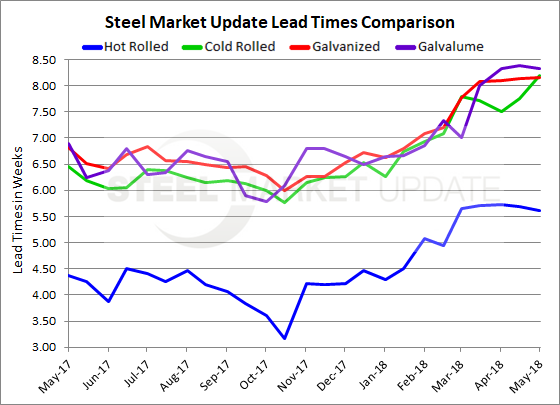SMU Data and Models

Lead Times Continue to be Extended
Written by John Packard
May 3, 2018
Compared to this time last year, flat rolled lead times are highly extended – on all products. Plate lead times, which is not on our graphic, are also highly extended, but we are treating it differently as the domestic mills are on controlled order entry/allocation with their plate customers.
Hot rolled lead times are averaging more than 5.5 weeks (5.62) based on the responses we received this week from our flat rolled steel market trends survey that was completed on Wednesday. One year ago, HRC lead times were averaging 4.37 weeks.
Cold rolled lead times are now out to an average of slightly more than 8 weeks (8.19). This is 1.5 weeks longer than the 6.5 weeks reported one year ago.
Galvanized lead times are much the same as cold rolled coming in at an average of 8.15 weeks. One year ago – 6.82 weeks.
Galvalume lead times are now, as they have been for the past six weeks, at an average of 8.33 weeks. One year ago, AZ lead times were just under 7 weeks (6.89).
The lead times referenced are from the responses we received from our flat rolled steel market trends analysis (survey), which we conduct twice per month. The respondents are either manufacturing companies, steel service centers or wholesalers. Steel mills and trading companies do not participate in this section of our analysis. We average the responses of the two groups to come up with an “average” lead time.
Note: These lead times are based on the average from manufacturers and steel service centers who participated in this week’s SMU market trends analysis. Our lead times do not predict what any individual may get from any specific mill supplier. Look to your mill rep for actual lead times on specific products Our lead times are meant only to identify trends and changes in the marketplace. To see an interactive history of our Steel Mill Lead Times data, visit our website here.

John Packard
Read more from John PackardLatest in SMU Data and Models

SMU’s June at a glance
A look at SMU data for the month of June.

SMU Survey: Buyers’ Sentiment rebounds from multi-year low
Both of SMU’s Steel Buyers’ Sentiment Indices edged higher this week. Current Sentiment rebounded from a near five-year low, while Future Sentiment rose to a two-month high

SMU flat-rolled market survey results now available
SMU’s latest steel buyers market survey results are now available on our website to all premium members.

SMU Survey: Sheet lead times pull back after early-June blip, plate holds
Following the uptick seen two weeks ago, lead times eased this week for all four sheet products tracked by SMU, while plate lead times held steady, according to this week’s market survey.

SMU Survey: Pricing power abruptly shifts to steel buyers
The majority of steel buyers responding to our latest market survey say domestic mills are more willing to talk price on sheet and plate products than they were earlier this month. Sheet negotiation rates rebounded across the board compared to early June, while our plate negotiation rate hit a full 100%.

